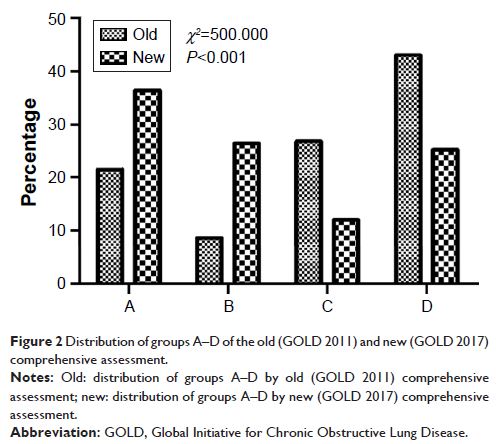9 7 8 1 6
论文已发表
注册即可获取德孚的最新动态
IF 收录期刊
- 3.3 Breast Cancer (Dove Med Press)
- 3.4 Clin Epidemiol
- 2.5 Cancer Manag Res
- 2.9 Infect Drug Resist
- 3.5 Clin Interv Aging
- 4.7 Drug Des Dev Ther
- 2.7 Int J Chronic Obstr
- 6.6 Int J Nanomed
- 2.5 Int J Women's Health
- 2.5 Neuropsych Dis Treat
- 2.7 OncoTargets Ther
- 2.0 Patient Prefer Adher
- 2.3 Ther Clin Risk Manag
- 2.5 J Pain Res
- 2.8 Diabet Metab Synd Ob
- 2.8 Psychol Res Behav Ma
- 3.0 Nat Sci Sleep
- 1.8 Pharmgenomics Pers Med
- 2.7 Risk Manag Healthc Policy
- 4.2 J Inflamm Res
- 2.1 Int J Gen Med
- 4.2 J Hepatocell Carcinoma
- 3.7 J Asthma Allergy
- 1.9 Clin Cosmet Investig Dermatol
- 2.7 J Multidiscip Healthc

定义的变化导致 GOLD 2017 下的各类 COPD 临床特征的变化:中国全国范围内的横断面调查
Authors Sun LN, Chen YH, Wu R, Lu M, Yao WZ
Received 28 May 2017
Accepted for publication 15 August 2017
Published 20 October 2017 Volume 2017:12 Pages 3095—3102
DOI https://doi.org/10.2147/COPD.S142801
Checked for plagiarism Yes
Review by Single-blind
Peer reviewers approved by Dr Charles Downs
Peer reviewer comments 3
Editor who approved publication: Dr Richard Russell
Purpose: To investigate how the changes of definition in assessment of
Global Initiative for Chronic Obstructive Lung Disease (GOLD) stratification
2017 lead to changes of chronic obstructive pulmonary disease (COPD) patient
clinical characteristics across categories in China.
Patients and methods: COPD patients from 11 medical centers in China were
stratified into old and new groups A–D twice according to the GOLD 2011 and
2017 comprehensive assessment. Demography and clinical characteristics were
compared between old and new groups A–D.
Results: In 1,532 COPD patients, the distribution from group A
to D was 330 (21.5%), 132 (8.6%), 411 (26.8%), 659 (43.0%) and 557 (36.4%), 405
(26.4%), 184 (12.0%), 386 (25.2%), respectively according to GOLD 2011 and
2017. 46.7% (500/1,070) patients in high-risk groups were regrouped to low-risk
groups. Compared to the old groups A and B, the new groups A and B had a
higher proportion of males, lower body mass index, higher modified Medical
Research Council (mMRC) grade, poor pulmonary function, more patients with
chronic bronchitis, and fewer patients with coronary heart disease and
hypertension disease. Compared to the old groups C and D, the new groups C and
D had older patients, fewer men, better pulmonary functions, frequent acute
exacerbations in the previous year, and more patients with chronic bronchitis,
coronary heart disease, or diabetes mellitus. The new group D had more
patients with stroke than the old group D.
Conclusion: In China, GOLD 2017 shifted the overall COPD
comprehensive assessments distribution to more low-risk groups. The new
high-risk groups had more characteristics associated with high risk of acute
exacerbation and mortality. Some of the changes in demography and clinical
characteristics of the new low-risk groups were associated with high risk of
acute exacerbation and/or mortality.
Keywords: chronic
obstructive pulmonary disease, risk stratification, symptom assessment, pulmonary
function tests
